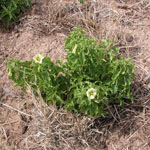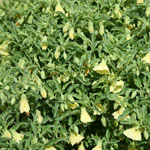Prairie ground cherry
Common name:
- Prairie ground cherry
Scientific name:
- Physalis hederifolia A. Gray
Other scientific name:
- Physalis viscosa L.
Other common names:
- Cape gooseberry
- Tomato weed
- Chinese lantern
Plant status
Catchment management authority boundaries
Regionally prohibited in the Wimmera catchment.
Regionally controlled in the Mallee, North Central, Corangamite, Goulburn Broken, North East, Port Phillip and Western Port catchments.
Restricted in the Glenelg Hopkins, West Gippsland and East Gippsland catchments.
Plant biology
Appearance
Herbaceous plant — Forb (flowering herbaceous plant — not a grass)
Description
Prairie ground cherry is an erect perennial herb 25 to 60cm high.
Stems
Stems of prairie ground cherry are branched, spreading, longitudinally ribbed and have very short hairs.
Leaves
Prairie ground cherry leaves are light green, alternate but with upper leaves often in opposite pairs. They are almost hairless on the leaf surface but with short hairs on margins and veins. Leaves are 6cm long, 4cm wide (commonly 4 to 5cm long and 3cm wide) with undulating margins.
Flowers
Prairie ground cherry flowers are yellow, bell-shaped and 2 to 3cm in diameter. They have 10 angled calyx and 5 petals that are fused. These are produced on stalks in axils of upper leaves.
Fruit
The fruit of prairie ground cherry is an orange coloured globular berry when ripe, 1 to 1.5cm in diameter, sticky and enclosed in a bladder-like case of about 2 to 2.5cm in diameter.
Growth and lifecycle
Method of reproduction and dispersal

Prairie ground cherry is spread by cultivation and pieces of root longer than 1.5cm that are capable of producing new plants.
The fruit, while enclosed in its bladder, is dispersed effectively by wind and water, so can spread along irrigation channels. Without its bladder, the sticky fruit adheres to most objects but this is not a major means of spread because the bladder is generally retained.
The fruit is eaten by birds, foxes and stock, and germination is enhanced after seeds pass through animals. The frequent occurrence of this weed along linear reserves can be linked to bird migration and animal droppings traced to known infestations.
The distribution of hay cut from infested areas is also an important means of the plant's dispersal.
Seedbank propagule persistence
Prairie ground cherry produces an estimated 15 berries per plant with 20 seeds per berry resulting in 300 seeds per plant.
Preferred habitat
Prairie ground cherry prefers warm-temperate regions, growing mostly on clay or loam soils. In southern Australia, it is a summer-growing plant of open grazing land occurring mostly in areas receiving 300 to 500mm annual rainfall.
Distribution
In Victoria, infestations can be found in the Goulburn Broken, Mallee, Port Phillip and Westernport, Corangamite catchments.
Growth calendar
The icons on the following table represent the times of year for flowering, seeding, germination, the dormancy period of prairie ground cherry and also the optimum time for treatment.
| Jan | Feb | Mar | Apr | May | Jun | Jul | Aug | Sep | Oct | Nov | Dec | |
|---|---|---|---|---|---|---|---|---|---|---|---|---|
| Flowering | ||||||||||||
Seeding | ||||||||||||
| Germination | ||||||||||||
| Dormancy | ||||||||||||
| Treatment |
Impact
Agricultural and economic impacts
Prairie ground cherry forms dense infestations in pastures, crops and roadsides, reducing available fodder and displacing desirable species. When well established, competes with other vegetation, particularly summer crops, for moisture, nutrients and space.
The weed is suspected of being poisonous but its foliage is rarely eaten by stock. Sheep readily eat the ripe fruit, apparently without ill effect.
Fodder produced from within infested areas is often a means of dispersal. Contaminated product may be unsuitable for sale. Grain quality may be affected through competition for moisture with Prairie ground cherry. The plant can interfere with crop harvesting.
Social value and health impacts
Dense patches of prairie ground cherry may create a negative visual effect but would not restrict human access to activities.
Management
Prescribed measures for the control of noxious weeds:
- application of a registered herbicide
- physical removal.
Read about prescribed measures for the control of noxious weeds.
Other management techniques
Changes in land use practices and spread prevention may also support Prairie ground cherry management after implementing the prescribed measures.